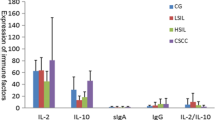Abstract
Objective
This study aims to identify the alterations in cervicovaginal flora after insertion of TCu 380A which is a popular type of copper IUD.
Study design
Among the women who visited the Department of Family Planning in our hospital during 1 month, 100 subjects who preferred IUDs for contraception and who had no history of local or systemic antibiotic use were considered eligible candidates.
Results
Anaerobic colonies, especially Gram-positive cocci and Gram-negative bacilli were isolated at significantly higher rates after the insertion of TCu-380A. Aerobic colonies were isolated relatively less.
Conclusions
It can be suggested that copper IUD causes the predominance of anaerobic species in the cervicovaginal flora, which is consistent with the literature. This clinically insignificant condition can be attributed to the copper content or threads of the IUDs. Yet there is no evidence that the prevalance of pelvic infections is influenced by the use of IUDs.
Similar content being viewed by others
References
Ämmälä M, Nyman T, Strengell L (1995) Effect of intrauterine contraceptive devices on cytokine messenger ribonucleic acid expression in the human endometrium. Fertil Steril 63:773
Chukudebelu WO (1980) Bacteriological study of IUDs removed from Nigerian Igbo. Int J Gynecol Obstet 17:355
Everett ED, Reller LB, Droegemuller W, Greer BE (1976) Absence of bacteremia after insertion or removal of intrauterine device. Obstet Gynecol 47:207
Farley MM, Rosenberg MJ, Rowe PJ et al (1998) Low risk of infection from IUD use shown. Contracept Technol Update 19(8):102–103
Grimes DA, Schulz KF (2000) Antibiotic prophylaxis for intrauterine contraceptive device insertion. Cochrane Database Syst Rev CD001327
Haukkama M (1987) Bacterial flora of the cervix in women using an intrauterine device. Contracept 36:527
Mohllajee AP, Curtis KM, Petersen HB (2006) Does insertion and use of an intrauterine device increase the risk of pelvic inflammatory disease among women with sexually transmitted infection? A systematic review. Contraception 73(2):145–153
Salem RM (2006) New attention to the IUD: expanding women’s contraceptive options to meet their needs. Popul Rep B (7):1–26
Sivin I, Diaz S, Pavez M et al (1991) Two-year comparative trial of the gyne T380 slimline and gyne T380 intrauterine copper device. Contraception 44:481
Sivin I, Stern J (1994) International Committee for Contraception Research. Health during prolonged use of levonorgestrel 20 mg/d and the copper TCu-380A intrauterine contraceptive devices; a multicenter study. Fertil Steril 61:70
Tinelli A, Tinelli R, Malvasi A et al (2006) The intrauterine device in modern contraception: still an actuality? Eur J Contracept Reprod Health Care 11(3):197–201
Tolcher R (2003) Intrauterine techniques: contentious or consensus opinion? J Fam Plann Reprod Health Care 29(1):21–24
United Nations Development Programme/United Nations Population Fund/World Health Organization/World Bank, Special Programme of Research, Development and Research Training in Human Reproduction (1997) Long-term reversible contraception. Twelve years of experience with the TCu-380A and TCu-220C. Contraception 56:341
Viberga I, Odlind V (2005) Microbiology profile in women with pelvic inflammatory disease in relation to IUD use. Infect Dis Obstet Gynecol 13(4):183–190
Wahab SA (1985) Effect of copper intrauterine device on cervicovaginal flora. Int J Gynecol Obstet 23:153
Wolf AS (1986) Bacterial colonisation of intrauetrine devices. Arch Gynecol 239:31
Author information
Authors and Affiliations
Corresponding author
Rights and permissions
About this article
Cite this article
Kanat-Pektas, M., Ozat, M. & Gungor, T. The effects of TCu-380A on cervicovaginal flora. Arch Gynecol Obstet 277, 429–432 (2008). https://doi.org/10.1007/s00404-007-0496-0
Received:
Accepted:
Published:
Issue Date:
DOI: https://doi.org/10.1007/s00404-007-0496-0




